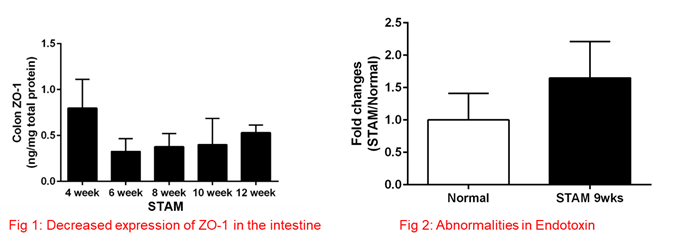Clinically correlated gut dysfunction in liver disease model
We would like to share with you our presentation from the 5th Korea Digestive Disease Week (KDDW 2021) (November 18 to 20, 2021).
ABS-0579| Molecular Pathogenesis of Non-Alcoholic Steatohepatitis (NASH) through the Dysregulation of Metabolic Organ Network in the NASH-HCC Model Mouse Treated with Streptozotocin-High Fat Diet
In this presentation, the increased intestinal permeability or leaky gut was confirmed in the STAM™ model. The data also suggested that changes in the intestinal environment might be involved in the onset and progression of the NASH pathology.
The STAM™ model developed by SMC Laboratories, Inc. is the world’s first mouse model that induces liver cancer from nonalcoholic steatohepatitis (NASH). It is a clinically-correlated murine NASH model which shows the same pathological progression as human NASH patients (fatty liver → NASH → liver fibrosis → HCC) and has been widely used for pharmacological and basic research. However, analysis of the model has focused on the liver.
We often see the gut liver axis dysfunction in NASH patients such as changing of bacterial, endotoxin, or leaky gut etc, which can cause and worsen the NASH (Lixin et al., Hepatology, 2012; Jay et al., CMGH, 2015). The gut and the liver are connected by the portal vein, through which about 70% of the blood supply to the liver passes. A series of bacteria, bacterial metabolites and toxins originating from the gut can affect the liver through the portal vein.
Therefore, considering organ crosstalk, interactions between the liver and the gut in the NASH patient, we performed the analysis with those phenotypes in the STAM™ model.
Tight junction-related proteins in the intestine of STAM™ showed that expression of ZO-1 decreased with the progression of the disease (Fig.1). Increased expression of endotoxin in the blood was also observed in the STAM™ mice (Fig.2).

In conclusion, decreased expression of ZO-1 in the intestine of STAM™ mice suggests the occurrence of leaky gut.
Other than the liver, if you have any compound targeting the intestinal environment, how about testing it in the STAM™ model?
